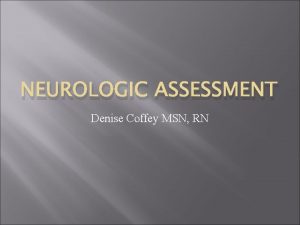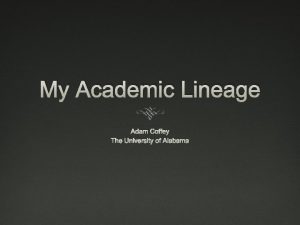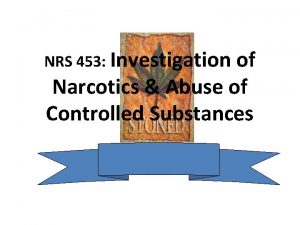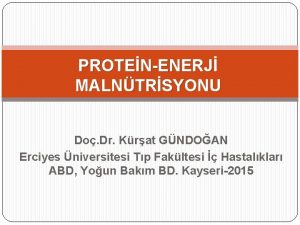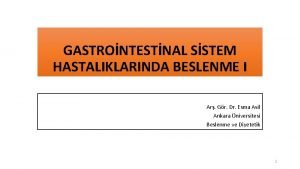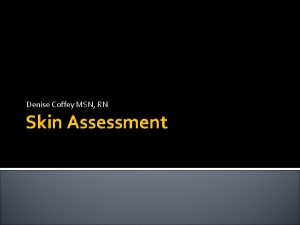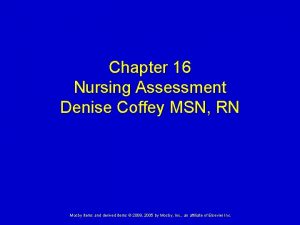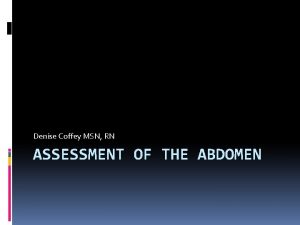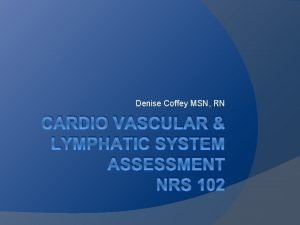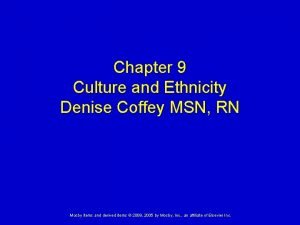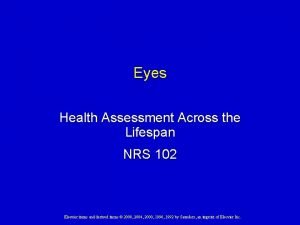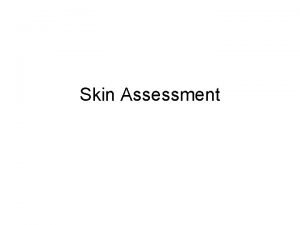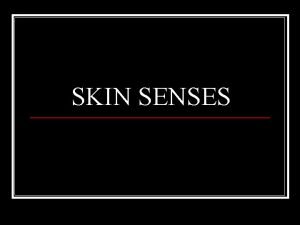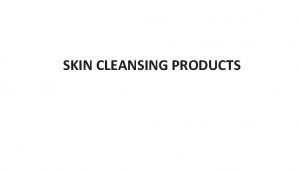Denise Coffey MSN RN NRS 102 Skin Assessment




















- Slides: 20

Denise Coffey MSN, RN NRS 102 Skin Assessment

�Structure and Function �Subjective Data—Health History Questions �Objective Data—The Physical Exam �Abnormal Findings Slide 12 -2

Structure and Function Skin—three layers 1. Epidermis Stratum germinativum or basal cell layer Stratum corneum or horny cell layer Derivation of skin color 2. Dermis Connective tissue or collagen Elastic tissue 3. Subcutaneous layer Slide 12 -3 � Epidermal appendages 1. Hair 2. Sebaceous glands 3. Sweat glands Eccrine glands Apocrine glands 4. Nails

Structure of Skin Slide 12 -4

Structure of Nails Slide 12 -5

Function of the Skin �Protection �Prevents penetration �Perception �Temperature regulation �Identification �Communication �Wound repair �Absorption and excretion �Production of vitamin D Slide 12 -6

Subjective Data—Health History �Previous history of skin disease (allergies, hives, psoriasis, or eczema) �Change in mole �Change in pigmentation (size or color) �Excessive dryness or moisture �Pruritus �Excessive bruising Slide 12 -7

Objective Data—The Physical Exam �Preparation External variables that influence skin color �Equipment needed Strong direct lighting Small centimeter ruler Penlight Gloves For special procedures ▪ Magnifying glass ▪ Materials for laboratory tests: glass slide Slide 12 -8

Objective Data—The Physical Exam (cont. ) �Skin—Inspect and palpate �Color General pigmentation Widespread color change ▪ Pallor ▪ Erythema ▪ Cyanosis ▪ Jaundice Slide 12 -9

Objective Data—The Physical Exam (cont. ) �Skin—Inspect and palpate (cont. ) �Temperature Hypothermia Hyperthermia �Moisture Diaphoresis Dehydration Slide 12 -10

Objective Data—The Physical Exam (cont. ) �Skin—Inspect and palpate (cont. ) �Texture �Thickness �Edema �Mobility and turgor �Vascularity or bruising Slide 12 -11

Objective Data— The Physical Exam (cont. ) �Skin—Inspect and palpate (cont. ) �Lesions Color Elevation Pattern or shape Size Location and distribution on body Exudate Slide 12 -12

Objective Data—The Physical Exam (cont. ) �Promoting health and self-care �Teach skin self-examination, using the ABCDE rule A—asymmetry B—border C—color D—diameter E—elevation and enlargement Slide 12 -13

Ulcer Slide 12 -14

Abnormal Findings Vascular Lesions � Hemangiomas Port-wine stain Petechiae (nevus flammeus) Strawberry mark (immature hemangioma) Cavernous hemangioma (mature) � Telangiectases Spider or star angioma Venous lake Slide 12 -15 Purpuric lesions Purpura Lesions caused by trauma or abuse Pattern injury Hematoma Ecchymosis (bruise)

Lesions caused by trauma or abuse: Ecchymosis Slide 12 -16

Abnormal Findings Common Skin Lesions in Children �Diaper dermatitis �Interigo (candidiasis) �Impetigo �Atopic dermatitis (eczema) �Measles (rubeola) �German measles (rubella) �Chickenpox (varicella) Slide 12 -17

Abnormal Findings Common Skin Lesions � Primary contact dermatitis � Allergic drug reaction � Tinea corporis (ringworm of the body) � Tinea pedis (ringworm of the foot) � Psoriasis � Tinea versicolor � Labial herpes simplex (cold sores) � Herpes zoster (shingles) � Erythema migrans of Lyme disease Slide 12 -18

Abnormal Findings Malignant Skin Lesions �Basal cell carcinoma �Squamous cell carcinoma �Malignant melanoma Slide 12 -19

A patient who is admitted for liver failure would be likely to show which of the following skin changes? A. B. C. D. Slide 12 -20 Cyanosis Flushing Rubor Jaundice
 Denise coffey death
Denise coffey death Denise coffey
Denise coffey Aoife coffey
Aoife coffey Jennifer coffey engaged
Jennifer coffey engaged Adam coffey
Adam coffey Vernon coffey
Vernon coffey Thick or thin skin
Thick or thin skin Thin skin vs thick skin
Thin skin vs thick skin Milady chapter 23 pdf
Milady chapter 23 pdf Nrs украина
Nrs украина Scala vas dispnea
Scala vas dispnea Nrs 453
Nrs 453 Critical thinking and the nursing process
Critical thinking and the nursing process Nrs 439
Nrs 439 Keylozis nedir tıp
Keylozis nedir tıp Nrs kipumittari
Nrs kipumittari Nrs 240
Nrs 240 Nrs 122
Nrs 122 Nurses touch socialization into professional nursing
Nurses touch socialization into professional nursing Nrs 2002 başlangıç taraması
Nrs 2002 başlangıç taraması Enteral beslenme ürünlerinin veriliş şekilleri
Enteral beslenme ürünlerinin veriliş şekilleri

